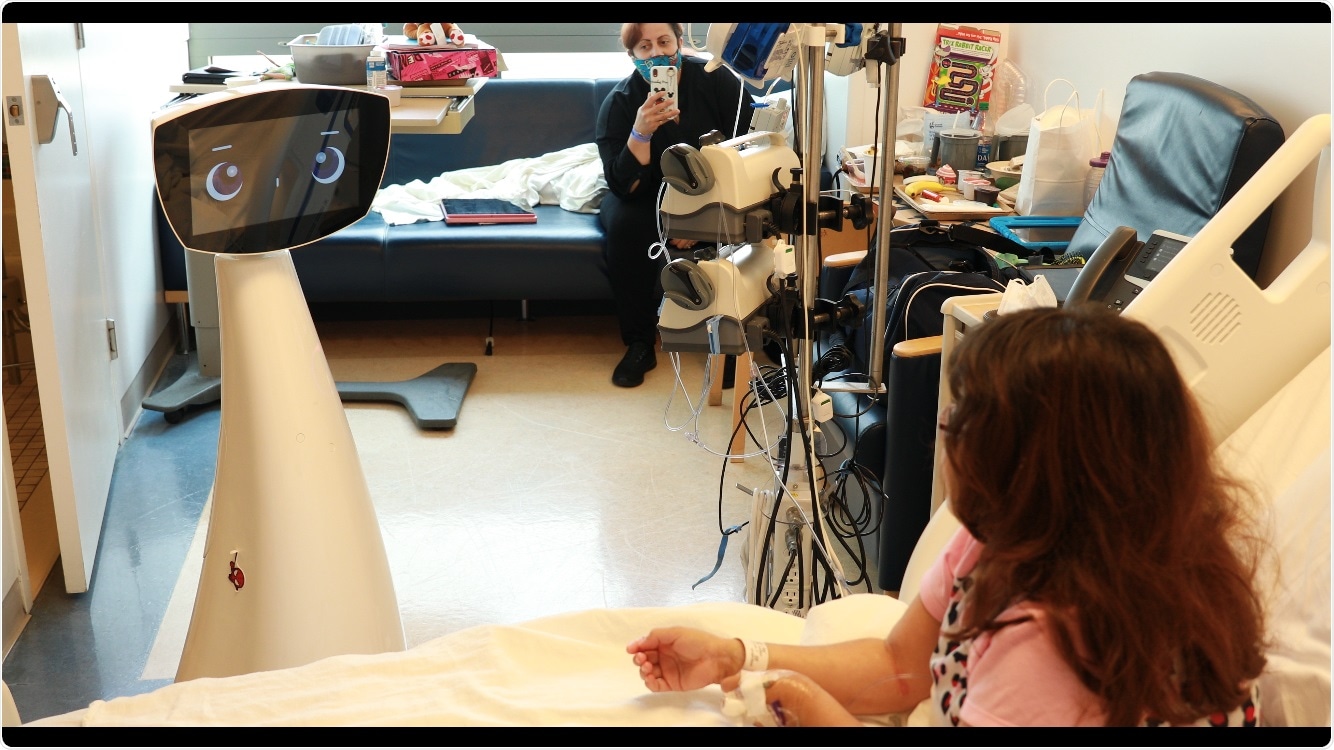In this interview, News-Medical speaks to Dr. Justin Wagner about Robin, the social companion robot, and how it is improving children’s hospital experiences.
Please can you introduce your work and tell us about what led you to carry out this study?
Robin is a social companion robot that was designed to support children in healthcare settings. In Armenia, where it was developed, it was preliminarily studied in outpatient clinics and showed promise in reducing children’s anxiety levels.
Prior to the pandemic, we were already interested to bring the most engaging technologies to support our pediatric patients. Our team met with Robin’s creators and we were struck by the robot’s capabilities, which seemed to represent the most advanced social support robotics we’d read about.
We conceived of a study to introduce Robin in an inpatient pediatric care setting, and we assembled a team of scientists, behavioral health experts, and Child Life specialists. The timing of the pandemic was serendipitous and accelerated the research plan.
As visitor restrictions were put into place, and emotional support services were limited during a time of uncertainty surrounding the transmission of COVID-19, we thought Robin could provide a crucial service in augmenting our Child Life specialists’ already amazing work.

Image Credit: UCLA Health
Your study found that communicating with children via a social robot improved their hospital experience. How was this study designed?
Under the circumstances of the pandemic, personal visits were restricted and remote interactions were becoming the new norm. We designed our study to compare the type of emotional support Child Life specialists could provide through two types of interactions: video chat with a Child Life specialist via a tablet versus telepresence with Child Life specialists projecting through Robin the Robot.
The children and their parents participated in surveys about the child’s positive and negative affect (conscious manifestations of emotion). Child Life specialists also participated in a focus group to discuss their perceptions of the benefits or challenges of operating Robin with their patients in the hospital.
How did you analyze your data and determine that the robot was having a positive effect on children’s experiences?
Our survey questions to children and their parents consisted of the validated Positive and Negative Affect Scale (PANAS), which we assessed before and after each visit. We compared the changes in each child’s positive and negative affect between those who received a tablet encounter and those who received a visit from Robin.
The PANAS scale was valuable in that we could evaluate the effects of each type of visit upon both positive and negative emotional states. While a boost in positive affect is a great outcome, a concurrent decrease in negative affect is even better.
Why do you think that the presence of the robot improved the hospital experience for children so much?
The way we designed the study, we were able to see how effectively Child Life specialists provide emotional support. When they operated the robot, their effects were amplified. While we are unfortunately unable to conclude from our data the exact reasons for those effects, there are a few that I suspect.
For one, I think children were more engaged by the physical presence of a life-sized being in the room rather than a 2-dimensional projection of a video chat. Robin also has a whimsey factor. The smooth frame, shiny white surface, and soft animated facial features are enchanting.
Robin The Robot on Fox11
How did this method enable children to have more control over their hospital experience?
I have to credit the Child Life specialists for developing an entire persona for the robot, a naïve being from an alien planet who is here to learn about the earth. The children taught Robin about where they live, songs they love, and their favorite dance moves.
I think the children felt comfortable to share and confide in this curious companion. They were the experts in this relationship, which is a role they rarely get to experience in the hospital.
How did the positive effects extend to families and healthcare workers?
Our most statistically compelling finding was that patients’ parents perceived a 75% reduction in negative affect after a visit with Robin and no change in negative affect after a tablet visit. To me, this is an incredibly meaningful finding.
To my patients, a reassured parent is every bit as important as any operation I perform. In the Child Life focus groups, the specialists identified that Robin gave them a greater sense of engagement, intimacy with their patients, patient-centered care, and ease of infection control measures while they provided their services.
Please can you give us some background on the robot, Robin, and how it was developed? How challenging is the operation of the robot?
Robin was developed in Armenia by Expper Technologies, Inc. Its creators intended Robin to provide companionship and distraction for pediatric patients who may be anxious in healthcare settings. They designed the robot to stand 4 feet tall with a frame that is curved to allow for an easy hug. They designed its face to have large, sympathetic eyes and equipped it with a voice modulator so that Robin speaks to its companion with a child’s voice.
The robot comes with a remote-controlled software suite that allows its operator to move its wheelbase, or project different emotional expressions, show videos or move its face panel. The Child Life specialists found that the biggest challenges included a learning curve and time commitment required to develop the robot’s persona and to remotely control it in real-time.
Expper hopes to develop future iterations of Robin driven by an artificial intelligence engine that will be capable of fully autonomous conversation. Robin currently has the capability to recognize and compute the emotional state projected by its companion’s facial expression, though we elected not to study this feature in our pilot study.
The world has undergone a big shift to using remote interaction more often in the aftermath of the pandemic. How could this study impact the future of doctor-patient interaction?
I see Robin as a creative way to break down barriers to sensitive communication during the pandemic and beyond. Social robots like Robin can be deployed in any healthcare setting to improve access to care via telepresence, or to provide emotional support to those with the greatest need. In its capacity as a pilot, our study was the first of what will hopefully be many following steps in demonstrating how social robotics benefit healthcare.
Importantly, we’ve shown that, even under the dramatic circumstances of the COVID-19 pandemic, Robin the Robot augments and enhances the hard work of the people who treat families at Mattel Children’s Hospital. That can and should be replicated and studied further at other centers.
How could these robots be made a regular part of inpatient pediatric care and do you think this sort of practice will become commonplace in our future?
Robin has allowed our Child Life specialists to engage with children who were otherwise inaccessible, either due to emotional factors such as fear, anxiety, and prior trauma, or physical barriers such as strict infection control measures. Even in our well-resourced hospital, Child Life specialists are in high demand.
I suspect we will see robots like Robin providing telepresence visits to children in settings like these where emotional support resources are otherwise restricted or cumbersome.

Image Credit: Phonlamai Photo/Shutterstock.com
How are robotics, in general, improving and aiding the medical sector? How will their influence develop over the next few years?
The whimsey factor is applicable in several aspects of medical care. Robots are used in some settings for smart transport of materials within hospitals, to augment a surgeon’s hands and instruments during difficult operations, and like Robin for emotional support. Those in emotional support are in their infancy, providing rudimentary functions and physical presence.
As artificial intelligence evolves over the next several years, its integration with robotics will result in an explosion of innovative ways to augment the experience of providing and receiving medical care. Robots may help inform us of the effectiveness of our care, give us more sophisticated assistance in surgical procedures, and expand the reach of our highest quality healthcare to those in remote settings with less access.
What is the next step for this study?
Now that we have demonstrated the feasibility of introducing Robin as a component of inpatient pediatric care, we are looking to expand our focus. We aim to determine how Robin’s enhanced facial expression recognition features can be used to enhance emotional support.
We intend to scale up the number of patient interactions to be able to draw more detailed conclusions about the extent to which robots augment emotional support. We will also look to other settings within our healthcare system to determine those with the greatest need, such as infusion centers, radiology suites, and even adult and geriatrics care settings.
Where can readers find more information?
About Dr. Justin Wagner
I am a pediatric surgeon at UCLA Mattel Children’s Hospital. I am certified in Surgery and Pediatric Surgery by the American Board of Surgery, and a Fellow of the American Academy of Pediatrics.
I am an Assistant Professor and Co-Chair of the Surgery Clerkship at the David Geffen School of Medicine of UCLA. My academic interests are in multimodal and comprehensive pediatric surgical care, domestic and international surgical education, and innovation and multimedia in medical education.